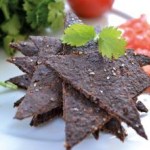cattle
Image of cricket chips called "chirps" from Six Foods. (http://www.sixfoods.com/#product)
Crickets are the first insect to now be farmed for human consumption in the United States. I'll admit the thought of snacking on cricket flour-based chips is not exactly appetizing. But the process of farming insects over more traditional livestock seems to be less wasteful. Insect farming is a more efficient way of producing dietary protein as it takes much less feed and water to raise insects as compared to cattle. In addition, greenhouse gas emissions from crickets are much lower than with cattle…
I read an interesting article today on how eating insects may save the world. The rationale: eating insects are not only nutritious (high in protein and fat), but would also help to save the Earth's resources as the human population continues to expand.
According to Aaron T. Dossey, a biochemist, entomologist, and founder and owner of All Things Bugs, humans consume ~40% of potential terrestrial productivity and livestock currently takes up ~30% of the Earth's land (pasture and growing feed). With the growing population of humans, food consumption will necessarily increase. He sees insects…
There are some papers out on the genome of the domestic cow out right now. ScienceNews has an overview:
Two competing research teams have cataloged the "essence of bovinity" found in the DNA of cattle, but not without disagreement on some essential points.
Reporting online April 23 in Science and April 24 in Genome Biology, the two groups compiled drafts of the bovine genome, identifying genes important for fighting disease, digesting food and producing milk.
I don't see the Genome Biology paper on the site yet, but there are two in Science. First, The Genome Sequence of Taurine Cattle: A…
Farmers and herders have known for centuries that herds of cattle have an uncanny ability to all point in the same direction. Last year, a group of German and Czech scientists discovered the reason behind this alignment - unbeknownst to humans for thousands of years of domestication, these animals have a magnetic sense. The team used Google Earth satellite images to rule out alternative explanations like the wind and the sun, and show that cow and deer herds tend to point towards magnetic north like a living, hoofed compass needle.
Now, the same team have found that high-voltage power lines…
If Arnold was a bovine, he'd look like this.
Now, the lady cows say that they find this disgusting, but all the boy cows don't believe that and are intimidated nonetheless.
But seriously, this looks to me like a mutation that we've known about for some time, and published versions of mice that look like this cow (but with cute little ears and a different tail) are also out there somewhere. Imagine this mutation in a human. Would that be a Neanderthal? Sort of?
Story here.
